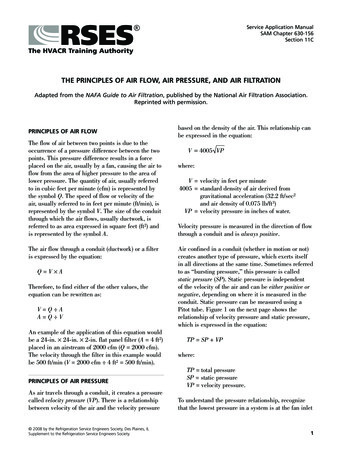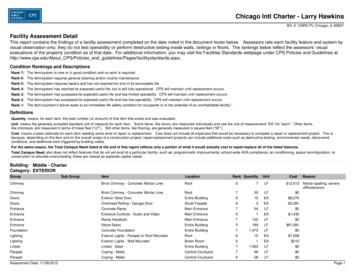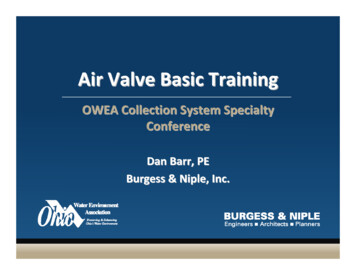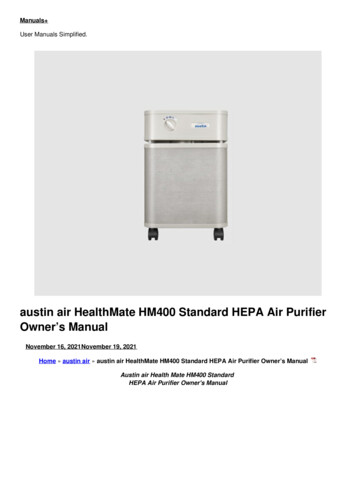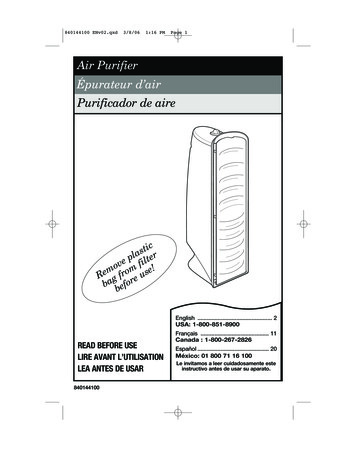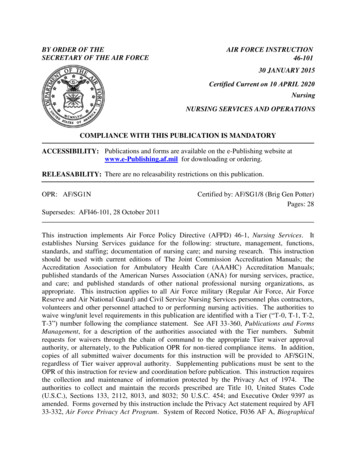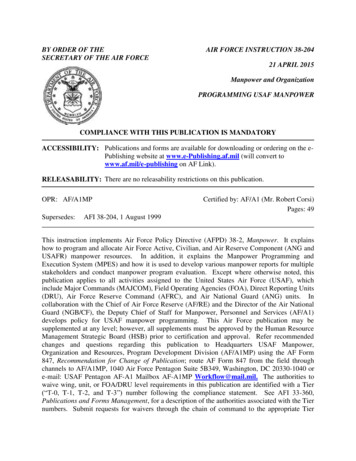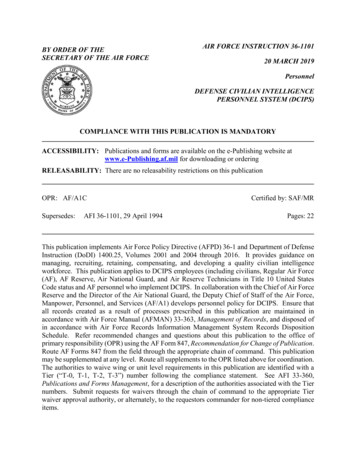
Transcription
BY ORDER OF THESECRETARY OF THE AIR FORCEAIR FORCE INSTRUCTION 36-110120 MARCH 2019PersonnelDEFENSE CIVILIAN INTELLIGENCEPERSONNEL SYSTEM (DCIPS)COMPLIANCE WITH THIS PUBLICATION IS MANDATORYACCESSIBILITY: Publications and forms are available on the e-Publishing website atwww.e-Publishing.af.mil for downloading or orderingRELEASABILITY: There are no releasability restrictions on this publicationOPR: AF/A1CSupersedes:AFI 36-1101, 29 April 1994Certified by: SAF/MRPages: 22This publication implements Air Force Policy Directive (AFPD) 36-1 and Department of DefenseInstruction (DoDI) 1400.25, Volumes 2001 and 2004 through 2016. It provides guidance onmanaging, recruiting, retaining, compensating, and developing a quality civilian intelligenceworkforce. This publication applies to DCIPS employees (including civilians, Regular Air Force(AF), AF Reserve, Air National Guard, and Air Reserve Technicians in Title 10 United StatesCode status and AF personnel who implement DCIPS. In collaboration with the Chief of Air ForceReserve and the Director of the Air National Guard, the Deputy Chief of Staff of the Air Force,Manpower, Personnel, and Services (AF/A1) develops personnel policy for DCIPS. Ensure thatall records created as a result of processes prescribed in this publication are maintained inaccordance with Air Force Manual (AFMAN) 33-363, Management of Records, and disposed ofin accordance with Air Force Records Information Management System Records DispositionSchedule. Refer recommended changes and questions about this publication to the office ofprimary responsibility (OPR) using the AF Form 847, Recommendation for Change of Publication.Route AF Forms 847 from the field through the appropriate chain of command. This publicationmay be supplemented at any level. Route all supplements to the OPR listed above for coordination.The authorities to waive wing or unit level requirements in this publication are identified with aTier (“T-0, T-1, T-2, T-3”) number following the compliance statement. See AFI 33-360,Publications and Forms Management, for a description of the authorities associated with the Tiernumbers. Submit requests for waivers through the chain of command to the appropriate Tierwaiver approval authority, or alternately, to the requestors commander for non-tiered complianceitems.
2AFI36-1101 20 MARCH 2019SUMMARY OF CHANGESThis document has been substantially revised and requires a complete review. Major changesinclude: (1) Replaced “Civilian Intelligence Personnel Management System (CIPMS)” with“Defense Civilian Intelligence Personnel System (DCIPS)”; (2) Aligned current policies withAFPD 36-1; and (3) Reformatted to meet AFI 33-360 requirements.Chapter 1— DEFENSE CIVILIAN INTELLIGENCE PERSONNEL SYSTEM (DCIPS)41.1.Overview. .41.2.DCIPS Policy. .4Chapter 2— ROLES AND RESPONSIBILITIES62.1.The Deputy Chief of Staff of the Air Force, Manpower, Personnel and Services(AF/A1) will: .62.2.The Deputy Chief of Staff of the Air Force, Intelligence, Surveillance,Reconnaissance, and Cyber Effects Operations (AF/A2/6). .62.3.Major Commands, Combatant Commands, Field Operating Agencies, and DirectReporting Units will: (T-2). .62.4.Installation-Level Civilian Personnel Section will: (T-3). .72.5.Unit commander will: (T-3). .72.6.Second-level Supervisor will: (T-3).72.7.Supervisor will: (T-3). .72.8.Employees will: (T-3). .7Chapter 3— GUIDANCE AND PROCEDURES83.1.Defense Civilian Intelligence Personnel System Introduction. .83.2.Adjustment in Force (AIF).83.3.DCIPS Employment and Placement. .93.4.Compensation Administration. .103.5.DCIPS Occupational Structure. .123.6.DCIPS Awards and Recognition. .13Table 3.1.DCIPS Special Act Award Approval Authorities. .143.7.DCIPS Disciplinary, Performance-Based, and Adverse Action Procedures. .153.8.DCIPS Professional Development. .16
AFI36-1101 20 MARCH 201933.9.DCIPS Performance Management. .173.10.DCIPS Performance-Based Compensation.183.11.DCIPS Program Evaluation. .183.12.DCIPS Employee Grievance Procedures. .183.13.DCIPS Special Categories of Employees. .183.14.Administration of Foreign Language Pay for DCIPS. .19Attachment 1— GLOSSARY OF REFERENCES AND SUPPORTING INFORMATION20
4AFI36-1101 20 MARCH 2019Chapter 1DEFENSE CIVILIAN INTELLIGENCE PERSONNEL SYSTEM (DCIPS)1.1. Overview. The DCIPS is a human resource management system for Department of Defense(DoD) intelligence positions as designated by the Secretary of the Air Force with the concurrenceof the Under Secretary of Defense for Intelligence [USD(I)]. It provides the human resources toolsnecessary to achieve the military and national intelligence missions. It incorporates DoD and AFintelligence positions under a single, performance-based, mission-focused personnel managementsystem. It serves as the common defense intelligence enterprise that helps to attract, retain, andreward the workforce needed to carry out critical national security missions. It supportsconsistency and transparency across the defense intelligence enterprise while simultaneouslyproviding the flexibilities to embrace AF culture with DCIPS positions.1.1.1. The DCIPS shall be the only civilian personnel system for AF intelligence positions,civilian DCIPS employees who occupy intelligence positions, and organizations designated ashaving an intelligence function. (T-0).1.1.2. This publication applies to AF civilian positions, employees or organizations engagedin or in support of an intelligence or intelligence-related mission as described by one of thefollowing methods:1.1.2.1. Organizational. All positions within commands and activities that have a primaryintelligence mission regardless of the occupational series.1.1.2.2. Occupational. Positions engaged in intelligence or intelligence related workrequiring a significant degree of specialized intelligence knowledge, skills, and abilities.1.1.2.3. Selected Positions. Position(s) in any occupational series providing direct supportof intelligence functions located within non-intelligence organizations and activities.1.1.3. Functional management officials, in conjunction with AF/A2/6 and AF/A1 willdetermine which positions are covered by DCIPS in accordance with USD(I) and AF policies.1.2. DCIPS Policy. Utilize this instruction in conjunction with DoDI 1400.25 Volume 2001 andVolumes 2004 through 2016, where indicated, to determine AF DCIPS guidance. (T-1). Unlessspecified in this publication, Office of Personnel Management (OPM), DoD, and AF publicationsand procedures do not apply to DCIPS. In the absence of established policy, guidance, orprocedure, consult with the Air Force Personnel Center (AFPC), Directorate of PersonnelPrograms (DP3) for assistance.1.2.1. All recruitment, development, and retention of qualified DCIPS personnel must: (T-1).1.2.1.1. Comply with merit systems principles.1.2.1.2. Be free of prohibited personnel practices.1.2.1.3. Support veterans’ special rights and privileges for federal civil serviceemployment.1.2.1.4. Provide a workplace free of sexual harassment and consistent with EqualEmployment Opportunity policies, laws, regulations and Executive Orders that prohibitunlawful discrimination based on race, color, religion, sex (including pregnancy, sexual
AFI36-1101 20 MARCH 20195orientation and gender identity), national origin, age, disability, genetic information,reprisal for protected activity, marital status, political affiliation or any other unlawfulfactor.1.2.1.5. Include a diverse pool of eligible, high quality candidates consistent with policiesin AFPD 36-70, Diversity & Inclusion.1.2.2. Utilize the DCIPS position alignment, recruitment, relocation, and retention incentives,and performance recognition to attract, compensate, and retain a high-quality intelligenceworkforce. (T-1).1.2.3. There are no separate DoDI 1400.25 Volumes for leave, benefits, and entitlements.DCIPS uses the leave, benefits, and entitlement programs common to all federal employees.
6AFI36-1101 20 MARCH 2019Chapter 2ROLES AND RESPONSIBILITIES2.1. The Deputy Chief of Staff of the Air Force, Manpower, Personnel and Services (AF/A1)will: (T-1).2.1.1. Develop, coordinate, and execute AF DCIPS policy and guidance.2.1.2. Provide policy revisions when required.2.1.3. Administer the DCIPS Awards and Recognition Program (identified in paragraph 3.6of this publication) jointly with the Deputy Chief of Staff of the Air Force, Intelligence,Surveillance and Reconnaissance (AF/A2/6).2.1.4. Coordinate with AF/A2/6 to develop the DCIPS Program Evaluation Plan.2.2. The Deputy Chief of Staff of the Air Force, Intelligence, Surveillance, Reconnaissance,and Cyber Effects Operations (AF/A2/6). AF/A2/6 is the Head of the AF for DCIPS positions.It will: (T-1).2.2.1. Collaborate with AF/A1 to develop, coordinate, and execute DCIPS policy.2.2.2. Provide policy guidance, direction, and leadership for DCIPS and intelligence,surveillance, and reconnaissance issues and missions.2.2.3. Provide a senior executive member within AF/A2/6, or as designated by AF/A2/6, toserve as the AF senior representative on the Defense Intelligence Human Resource Board.This representative is responsible to address and provide recommendations to OUSD(I) onDCIPS human capital issues.2.2.4. Administer DCIPS awards and recognition programs (identified in paragraph 3.6 ofthis publication) jointly with AF/A1.2.2.5. Develop, in coordination with AF/A1, the DCIPS Program Evaluation Plan.2.3. Major Commands, Combatant Commands, Field Operating Agencies, and DirectReporting Units will: (T-2).2.3.1. Direct the implementation of DCIPS, ensuring that any supplemental command-widepolicies and procedures are flexible, cost-effective and efficient.2.3.2. Evaluate implementation and effectiveness of DCIPS program to ensure alignment withthe goals and objectives of the AF/A2/6 Strategic Plans.2.3.3. Determine, recommend, and monitor personnel management resource requirementsnecessary to support intelligence functions within their control.2.3.4. Ensure DCIPS employees and their rating and reviewing officials receive mandatoryDCIPS training as defined by AF/A2/6, Office of Director of National Intelligence, andUSD(I). This includes all supervisors and managers (civilian and military) of AF DCIPSemployees.2.3.5. Delegate authorities and assign responsibilities regarding civilian personnelmanagement to the intelligence commander at major command, combatant command orequivalent level, and senior intelligence officer.
AFI36-1101 20 MARCH 201972.3.6. Develop DCIPS administrative return rights guidance and procedures to place civiliansreturning from overseas assignments. Reference paragraph 3.3.12. of this publication.2.4. Installation-Level Civilian Personnel Section will: (T-3).2.4.1. Administer DCIPS.2.4.2. Provide DCIPS advisory services to commanders, directors, managers, supervisors andemployees.2.4.3. Coordinate with the DCIPS hiring manager to recruit without a public notification orvacancy announcement; validate verbiage in a public notification or vacancy announcement;determine appropriate applicant recruitment sources; and determine applicable targetingrecruitment.2.4.4. Assist supervisors in administering disciplinary actions, suspensions, and removals.2.5. Unit commander will: (T-3).2.5.1. Determine additional competitive areas and status of detailed employees during anadjustment in force described in paragraph 3.2.2.5.2. Approve DCIPS pay setting for steps 6 through 10.2.5.3. Ensure completion of DCIPS performance plans and individual development plans.2.6. Second-level Supervisor will: (T-3).2.6.1. Approve DCIPS pay setting for steps 1 through 5.2.6.2. Approve DCIPS Special Act Awards (identified in paragraph 3.6 of this publication)up to 500.2.7. Supervisor will: (T-3).2.7.1. Manage employee discipline and performance. Coordinate all disciplinary action withthe servicing civilian personnel section.2.7.2. Recommend DCIPS starting pay.2.8. Employees will: (T-3).2.8.1. Adhere to established civilian standards of conduct and individual responsibilityidentified in AFI 36-703, Civilian Conduct and Responsibility.2.8.2. Participate in developing an annual performance plan and individual development plan.2.8.3. Provide written midpoint and annual self-report of accomplishments.
8AFI36-1101 20 MARCH 2019Chapter 3GUIDANCE AND PROCEDURES3.1. Defense Civilian Intelligence Personnel System Introduction.3.1.1. Comply with policies and responsibilities for the development, management, andevaluation of DCIPS employees and programs established in DoDI 1400.25, Volume 2001,Defense Civilian Intelligence Personnel System (DCIPS) Introduction. (T-0).3.1.2. Presidential Policy Directive 19, Protecting Whistleblowers with Access to ClassifiedInformation, and Directive-type Memorandum 13-008, DoD Implementation of PresidentialPolicy Directive 19 prohibits reprisal against all DCIPS employees for protected disclosures.No officer or employee may take, fail to take, threaten to take, or threaten to fail to take, apersonnel action against any employee serving in a DCIPS position, including DISES andDISL members, as a reprisal for a protected disclosure pursuant to Presidential Policy Directive19. Any DCIPS employee that suspects refusal to access classified information as a form ofreprisal for protected disclosure under Presidential Policy Directive 19 may file a complaintthrough the Office of the Air Force Inspector General. Use AFI-90-301, Inspector GeneralComplaints Resolution, to submit the complaint. Refer to DoDI 1400.25, Volume 2001,Enclosure 2, paragraph 3.d.3.1.3. DCIPS employees may request a review of all personnel actions they allege to violatesection A of Presidential Policy Directive 19 as form of reprisal for protected disclosure. Filea complaint through the Office of the Air Force Inspector General using AFI-90-301 to submitthe complaint. Refer to DoDI 1400.25, Volume 2001, Enclosure 2, paragraph 3.e.3.1.4. AF/A2/6 will designate or dismiss AF intelligence positions in coordination withUSD(I). (T-0). Refer to DoDI 1400.25, Volume 2001, Enclosure 2, paragraph 4.3.1.5. AF/A1 will implement and administer DCIPS. Refer to DoDI 1400.25, Volume 2001,Enclosure 2, paragraph 5.3.2. Adjustment in Force (AIF).3.2.1. Comply with policies, responsibilities and procedures for administering an AIFestablished in DoDI 1400.25, Volume 2004, Defense Civilian Intelligence Personnel System(DCIPS) Adjustment in Force (AIF).3.2.2. The first Defense Intelligence Senior Executive Service or equivalent in the chain ofcommand will serve on the AIF Appeals Committee. (T-1). Refer to DoDI 1400.25, Volume2004, Enclosure 2, paragraph 5.d.3.2.3. The unit commander or director will determine additional factors to combine with thegeographic location to determine a competitive area. (T-3). Refer to DoDI 1400.25, Volume2004, Enclosure 3, paragraph 1.3.2.4. The unit commander from the permanent unit of DCIPS employee completing atemporary assignment to a location undergoing an AIF will determine whether to allow theemployee to complete the assignment or return to the permanent position. (T-3). Refer toDoDI 1400.25, Volume 2004, Enclosure 3, paragraph 4.f.
AFI36-1101 20 MARCH 201993.2.5. Employees have seven calendar days from the issue date of the notification memo toaccept or reject an offer for a position. (T-3). Refer to DoDI 1400.25, Volume 2004, Enclosure3, paragraph 4.f.3.3. DCIPS Employment and Placement.3.3.1. Comply with policies, guidance, and responsibilities to recruit, promote, and detailDCIPS employees established in DoDI 1400.25, Volume 2005, Defense Civilian IntelligencePersonnel System (DCIPS) Employment and Placement.(T-0).3.3.2. All units will use the “rank-in-position” construct for all DCIPS positions vice “rankin-person”. (T-1). Refer to DoDI 1400.25, Volume 2005, Enclosure 2, paragraph 1.f.3.3.3. The servicing civilian personnel section will review and approve the following beforeany DCIPS recruitment efforts commence:3.3.3.1. Decision to recruit without a public notification or vacancy announcement. (T-3).Refer to DoDI 1400.25, Volume 2005, Enclosure 2, paragraph 6.b.3.3.3.2. Public notifications and advertisements. Post all DCIPS public notifications,vacancy announcements and advertisements for a minimum of three calendar days. (T-3).Refer to DoDI 1400.25, Volume 2005, Enclosure 2, paragraphs 6.c. and 8.3.3.3.3. Applicant recruitment sources. (T-3). Refer to DoDI 1400.25, Volume 2005,Enclosure 2, paragraph 7.3.3.3.4. Targeting Recruitment. (T-3). Refer to DoDI 1400.25, Volume 2005, Enclosure2, paragraph 14.3.3.4. Adopt OPM qualification standards in the absence of USD(I) qualification standards.(T-0). These standards are available in the OPM General Schedule Qualifications chedule-qualification-standards/. Refer to DoDI 1400.25, Volume2005, paragraph 5.c.(2) and Enclosure 2, paragraph 9.b.3.3.5. Indicate the conditions of employment on all position descriptions required for eachDCIPS position. (T-2). Refer to DoDI 1400.25, Volume 2005, Enclosure 2, paragraph 10.3.3.6. Goals and metrics used to measure quality in employment and placement outcomes forDCIPS will mirror those for competitive service positions. (T-1). Refer to DoDI 1400.25,Volume 2005, Enclosure 2, paragraph 13.3.3.7. The selecting official should narrow selections to the top three candidates, all beingsubstantially equally-qualified. When at least one applicant is veterans’ preference eligible,the veteran must receive the job offer before non-preference eligible applicants. (T-0). Referto DoDI 1400.25, Volume 2005, Enclosure 2, paragraph 15.a.3.3.8. Do not apply veterans’ preference to DCIPS candidates with prior federal service. (T1). Refer to DoDI 1400.25, Volume 2005, Enclosure 2, paragraph 15.b.3.3.9. DCIPS employees must complete the required trial period (as defined in DoDI 1400.25,Volume 2005) in an uninterrupted block of time. (T-0). Separation procedures identified inDoDI 1400.25, Volume 2009, Defense Civilian Intelligence Personnel System (DCIPS)Disciplinary, Performance-Based, and Adverse Action Procedures, do not apply to separation
10AFI36-1101 20 MARCH 2019during a trial period. The supervisor must coordinate separation with the servicing civilianpersonnel section employee management relations specialist before notifying the employee.(T-3). The supervisor will provide, in writing, the reason(s) for separation to the employeemanagement specialist to review and begin the separation process. (T-3). Management willdetermine the employee’s separation date. (T-3). Refer to DoDI 1400.25, Volume 2005,Enclosure 2, paragraph 16.3.3.10. Upon validation from the servicing civilian personnel section, noncompetitivelypromote employees when the application of a new job grading standard or correction of aposition alignment (also known as classification) results in an assignment to a position with ahigher work level or grade. (T-3). Refer to DoDI 1400.25, Volume 2005, Enclosure 2,paragraph 18.c.(6).3.3.11. The classification team at AFPC will make a recommendation on the appropriatenessof a promotion resulting from an accretion of duties. The servicing civilian personnel sectionwill validate all noncompetitive accretion of duties promotions in the same work category oroccupation. The civilian personnel section may permit a noncompetitive promotion if no otheremployee in the geographic area possesses qualifications to hold the affected position. Thecivilian personnel section will ensure open competition if another employee meets thequalification for the position. Refer to DoDI 1400.25, Volume 2005, Enclosure 2, paragraph18.c.(7).3.3.12. DCIPS overseas tour lengths and rotations are defined in DoDI 1400.25, Volume 1230,Employment in Foreign Areas and Employee Return Rights and Air Force policy in Air ForceManual (AFMAN)36-204. DCIPS employees have no statutory right of return to the previousposition, unit, or geographic location. The owning major command, combatant command oragency to which the employee was assigned before taking the overseas position is responsibleto afford DCIPS employees administrative return to a non-foreign area upon completion of theoverseas tour. (T-2). DCIPS employees recruited to an overseas location or new to federalservice when recruited will use the Priority Placement Program and the applicable career fieldteam for administrative return; whichever comes first. (T-1). Refer to DoDI 1400.25, Volume2005, Enclosure 2, paragraph 24.c.3.4. Compensation Administration.3.4.1. Comply with policies, definitions, responsibilities, procedures, and design of DCIPScompensation administration established in DoDI 1400.25, Volume 2006, Defense CivilianIntelligence Personnel System (DCIPS) Compensation Administration. (T-0).3.4.2. All units will use the pay grade associated with the applicable position description tocompensate its DCIPS employees. (T-1). Follow this guidance for all references to “pay bandsor grades” within all the DCIPS volumes. Refer to DoDI 1400.25, Volume 2006, Enclosure3, paragraph 10.3.4.3. To set pay for new DCIPS appointments: (T-2).3.4.3.1. Use the general schedule pay scale based upon locality, grade, and step. Applylocal market supplements, targeted local market supplements, and special salary rates toapplicable DCIPS occupational series defined by USD(I). Refer to DoDI 1400.25, Volume2006, Enclosure 3, paragraph 10.d.(1).
AFI36-1101 20 MARCH 2019113.4.3.2. Evaluate previous experience and work history related to the new DCIPS position.Consider the applicant’s depth and breadth of experience related to the DCIPS position heor she will fill and set pay within the current grade at a step reflective of experience. If theapplicant’s experience does not merit a higher starting salary, pay should be set at step 1.3.4.3.3. Evaluate prior salary received for performing work similar or related to the newDCIPS position. Consider the applicant’s prior salary history as it relates to the DCIPSposition he or she will fill. Pay may be set commensurate with or lower than the priorsalary within the current grade. Refer to DoDI 1400.25, Volume 2006, Enclosure 3,paragraph 10.d.(3).3.4.3.4. When establishing starting salary for a new DCIPS employee assigned to a workcenter with other DCIPS employees performing similar work with the same series andgrade, consider their experience level and current pay. Set starting pay for the new DCIPSemployee commensurate with the experience level and current pay of an existing workcenter employee. Refer to DoDI 1400.25, Volume 2006, Enclosure 3, paragraph 10.d.(4).(T-3).3.4.3.5. Obtain applicant’s supervisor and second-level supervisor approval to set pay atsteps 1 through 5 of the applicable grade. Obtain unit commander or director approval toset pay at steps 6 through 10. Refer to DoDI 1400.25, Volume 2006, Enclosure 3,paragraph 10.d.(5).3.4.3.6. Consider past precedent-setting decisions in determining appropriate salary andapply them where appropriate. Validate data used for previous pay setting decisionsapplicable to the current situation and adjust information and salary ranges offered,appropriately. Refer to DoDI 1400.25, Volume 2006, Enclosure 3, paragraphs 10.d.(5) and10.d.(6).3.4.4. DCIPS employees may advance in grade through a developmental program. Seeoptions provided in the Air Force DCIPS Developmental Guide available %20Program/Forms/AllItems.aspx.Refer to DoDI 1400.25, Volume 2006, Enclosure 3, paragraph 11.d. Refer to DoD 1400.25,Volume 2006, Enclosure 3, paragraph 12.b.3.4.5. DCIPS employees may volunteer for a reduction to a lower grade for various reasons.Use DoD 1400.25, Volume 2006, Enclosure 3, paragraph 12.b. to set employee pay for thesereductions. (T-0).3.4.5.1. Employees may volunteer for a reduction to a lower grade to accept a target-gradeposition for career growth and development. When these employees promote back to thegrade held before the reduction, use DoDI 1400.25, Volume 2006, Enclosure 3, paragraph10.g.(2)(a) to set pay. (T-0). Refer to DoD 1400.25, Volume 2006, Enclosure 3, paragraph12.b.3.4.5.2. Employees may volunteer for a reduction to a lower grade for reasons other thanto accept a target-grade position. Should these employees promote back to the grade heldbefore the reduction, set pay at the current rate by aligning it to the closest step of the newgrade that is not less than the employee’s current salary. (T-0). Refer to DoD 1400.25,Volume 2006, Enclosure 3, paragraph 12.b.
12AFI36-1101 20 MARCH 20193.4.6. Management may direct an involuntary reduction to lower grade to effect amanagement-directed reassignment. Use DoD 1400.25, Volume 2006, Enclosure 3, paragraph13c. to set employee pay. Should management promote these employees back to the gradeheld before the reduction, set pay at the current rate by aligning it to the closest step of the newgrade that is not less than the employee’s current salary. Refer to DoD 1400.25, Volume 2006,Enclosure 3, paragraph 13.c.3.4.7. For the purposes of implementing DoDI 1400.25, Volume 2006, Enclosure 3, paragraph13.c., in reference to management-directed reassignments, the term “management” includesthe unit commander, director, or manager determining such reassignments. Whenaccomplishing an AIF or other workforce reshaping initiative, include the civilian personnelofficer as “management”. (T-3).3.4.8. Use the guidance and procedures in AFI 36-802, Pay Setting, Chapter 4, paragraphs 4.1through 4.6. for recruitment, retention, and relocation incentives for DCIPS employees. Referto DoDI 1400.25, Volume 2006, Enclosure 3, paragraph 17.b.(1).3.5. DCIPS Occupational Structure.3.5.1. Comply with policies and responsibilities for DCIPS occupational structure design andadministration established in DoDI 1400.25, Volume 2007, Defense Civilian IntelligencePersonnel System (DCIPS) Occupational Structure. (T-0).3.5.2. All units will use rank-in-position structure and pay grades with general government, or“GG”, graded structure. (T-1). Refer to DoDI 1400.25, Volume 2007, Enclosure 3, paragraphs1.b. and 1.c.3.5.3. DCIPS managers may request position alignments that include target-grade positions todevelop employees to the Full Performance Work Level in the Professional Work Category.Refer to DoDI 1400.25, Volume 2007, Enclosure 3, paragraph 2.b. and DoDI 1400.25, Volume2005, Enclosure 3, paragraph 18.c.(5).3.5.3.1. Depending upon the nature of the work, the Entry/Developmental Work Level 1starting grade may range from GG-7 to GG-10. The Full Performance Work Level 2 targetgrade (or final grade) may range between GG-11 to GG-13. Refer to DoDI 1400.25,volume 2007, Appendix 5 to Enclosure 3.3.5.3.2. A target-grade position may not exist in the Technical/Administrative SupportWork Category or Supervision/Management Work Category. Refer to DoDI 1400.25,Volume 2005, Enclosure 3, paragraph 18.c.(5).3.5.4. An employee without the technical background or commensurate education ofsubordinates may supervise technical employees or those with advanced education to supporttheir occupational series; e.g., GG-0855, GG-1515, GG-1550. Such instances require thesupervisor have a subject matter expert in the organization who can review the subordinate’swork for technical sufficiency. (T-3). Refer to DoDI 1400.25, Volume 2007, Appendix 3 toEnclosure 3, paragraph 3.a.3.5.5. In the absence of USD(I) guidance for aligning supervisor positions, use the OPMGeneral Schedule Supervisory Guide as a reference. (T-1). The guide is available fication-qualifications/classifying-
AFI36-1101 20 MARCH /gssg.pdf . Refer to DoDI 1400.25, Volume2007, Appendix 4 to Enclosure 3, paragraph 3.3.6. DCIPS Awards and Recognition.3.6.1. Comply with policy, responsibilities, and guidance for DCIPS awards and recognitionprograms established in DoDI 1400.25, Volume 2008, Defense Civilian Intelligence PersonnelSystem (DCIPS) Awards and Recognition. (T-0). To receive an award, DCIPS employeesmust meet basic eligibility in accordance with DoDI 1400.25, Volume 2008, Enclosure 3,paragraph
2.6.1. Approve DCIPS pay setting for steps 1 through 5. 2.6.2. Approve DCIPS Special Act Awards (identified in . paragraph 3.6. of this publication) up to 500. 2.7. Supervisor will: (T-3). 2.7.1. Manage employee discipline and performance. Coordinate all disciplinary action with the servicing civilian personnel section. 2.7.2. Recommend DCIPS .





